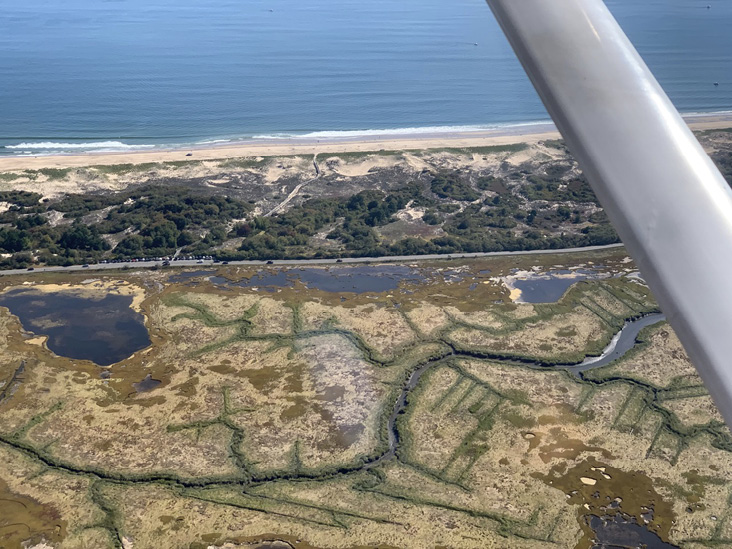Nancy Pau, Patricia Huckery, and Russ Hopping

Figure 1. Salt marsh at Parker River National Wildlife Refuge (part of 100-acre marsh). This aerial view shows large pools forming at the upland edge of the salt marsh as old agricultural ditches clog and old embankments impound water. The darker signature in the aerial photos shows areas where water is trapped and may turn into open water. Photograph by Maria Parisi, USFWS.
Nancy Pau remembers feeling a range of emotions as she watched Hunt Durey zoom about in Google Earth showing one saltmarsh area after another converting from healthy marsh to open water: shock, distress, sorrow. It was 2014, and a group of people who work regularly in salt marshes had been observing dramatic and alarming changes in their marshes. To understand what was causing these changes, marsh managers, regulators, mosquito-control folks, and researchers had convened an ad-hoc gathering to share what they had noticed. Hunt, an ecologist with the Massachusetts Department of Ecological Restoration, was the last of a series of presenters to share his observations. Like pieces of a puzzle coming together, as each presenter shared his or her perspective, it was fast becoming obvious that the marsh was changing and that degradation was widespread and prevalent. The Great Marsh needed help—and fast—given rising sea levels and future modeling that indicated the marsh was in peril of being drowned within a few decades. For those of us charged with protecting the Great Marsh, seeing the rapid changes throughout the marsh caused great concern, but little understanding existed as to why the marsh was rapidly deteriorating and what could be done about it.
The Great Marsh is the largest saltmarsh ecosystem north of New Jersey. Totaling 20,000 acres, it stretches from Gloucester, Massachusetts, to Hampton, New Hampshire. It comprises 16,000 acres of salt marsh and miles of undeveloped sandy beaches. Its rich wildlife resources sustained the indigenous Penacook tribe that lived around the Merrimack River for thousands of years, and they attracted the English colonists who settled in the region in the 1600s. Today, the marsh and beaches support some of the best coastal habitat in all New England and are an integral part of the identity of nine communities in Massachusetts: Gloucester, Rockport, Essex, Ipswich, Rowley, Newbury, Newburyport, Amesbury, and Salisbury.
To view the rest of the article you'll need to
subscribe. Bird Observer publishes original articles on birding locations, on avian populations and natural history, on regional rarities, field notes, field records, photographs, and art work.